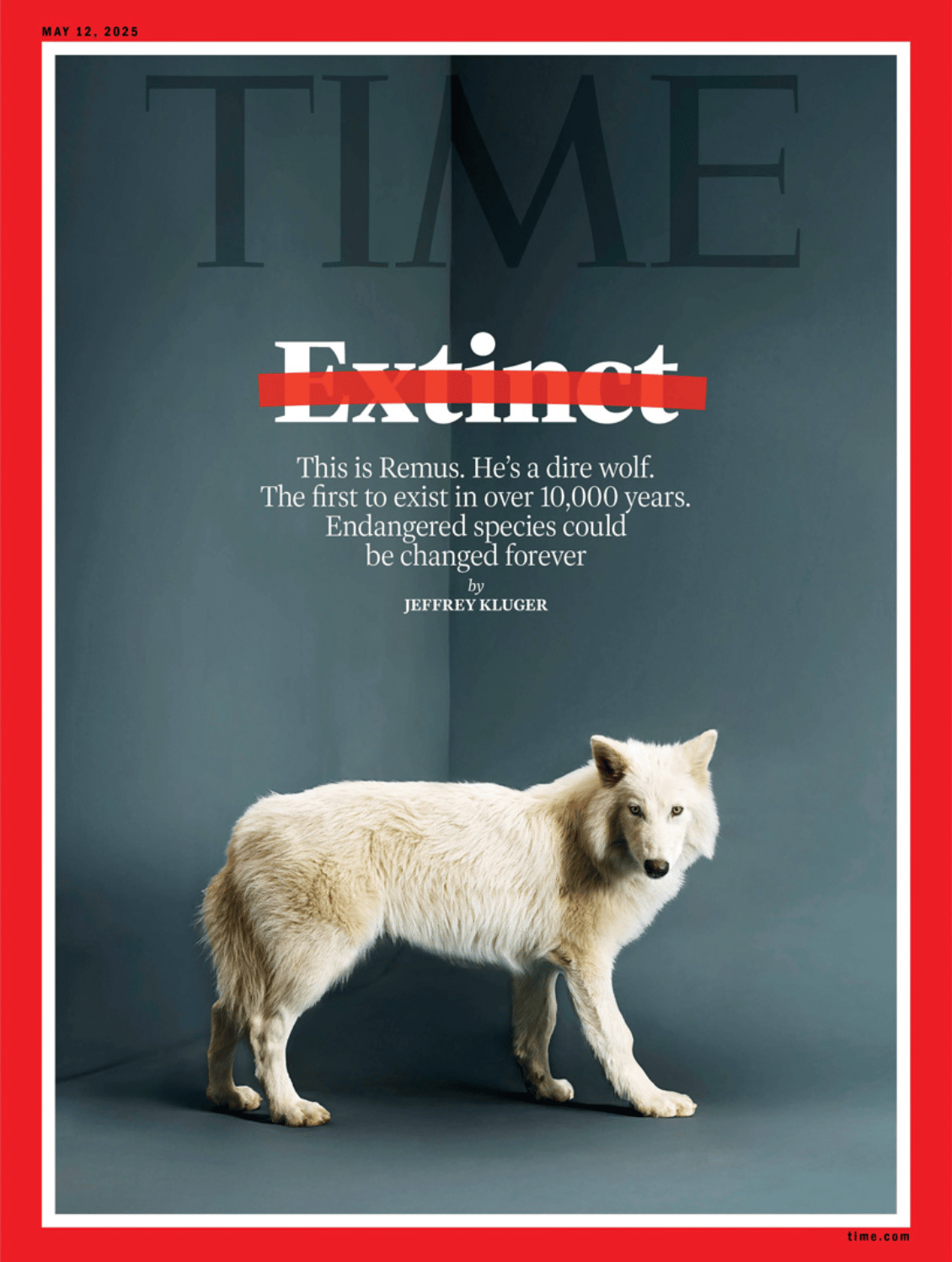It’s Saturday, April 12, 2025.
Project 18:15 turned two this week! This is the 105th edition of the newsletter, which has been published every weekend since its launch on April 8, 2023. If you appreciate this work, don’t hide it under a bushel! The best way to support Project 18:15 is by sharing it with a friend who may enjoy it. Would you forward this email or send this webpage link?
Today’s edition covers some Christian ethical considerations of a de-extinction effort, China’s move to block missionary work, the final installment of our eschatology series (i.e., the last installment about last things 😅), and more.
“Give instruction to a wise man, and he will be still wiser; teach a righteous man, and he will increase in learning.” (Proverbs 9:9)
Of Christian Concern
CHRISTIAN ETHICS ON THE DIRE WOLF’S “DE-EXTINCTION”

Cover of TIME, May 12, 2025. Photograph by Robert Clark for TIME.
“The dire wolf is back after over 10,000 years,” wrote Time on social media this week. The news site’s article describes how a company called Colossal Biosciences used “ancient, preserved DNA” to map the dire wolf genome, edit gray wolf genes “to match it,” and oversee the birth (via surrogacy) of three dire wolves, a species of wolf that is said to have gone extinct millennia ago.
While this presentation of the project offers Colossal’s “de-extinction” narrative in a seemingly uncritical fashion, some reactions to the news have been less credulous or laudatory.
To achieve the result of unusually large wolves with a particular face shape and striking white hair, the biotech company made 20 genetic changes across 14 genes. Does that make it a dire wolf? As reported in MIT Technology Review, biological science scholar Anders Bergström, who specializes in the study of canines, says no.
“I would say such an animal is not a dire wolf and it’s not correct to say dire wolves have been brought back from extinction. It’s a modified gray wolf. . . . Twenty changes is not nearly enough. But it could get you a strange-looking gray wolf.”
Dire wolf or not, does Christianity have anything to say about cloning animals like this? After an email exchange with a professor of Christian ethics, here are four general points to consider regarding biomedicine and biotechnology (cloning, stem cell research, etc.).
1. We should recognize that humans are different from animals.
We alone are created in God’s image (Genesis 1:27) and are, therefore, more valuable (Luke 12:7). So, even if cloning animals is morally permissible, that doesn’t mean cloning humans is.
2. Still, we need to care about and for animals.
Our God-given dominion over the animals (Genesis 1:26-28; Psalm 8:6-8) implies a duty to care for them. As the proverb says explicitly, “Whoever is righteous has regard for the life of his beast” (Proverbs 12:10a). The vast majority of cloning attempts fail (the average success rate is only 9.4 percent), and “successful” clones often suffer from many ailments. Also, introducing new or “de-extinct” animals could disrupt animal ecosystems.
“Colossal claims that the same techniques it uses to summon back species from the dead could prevent existing but endangered animals from slipping into extinction themselves,” the Time article reports. Is this a way of caring for the animals? Maybe. But what about the animal suffering we cause in the process? For that matter, are we “playing God” by trying to save a species that would otherwise naturally go extinct? What is the balance of our responsibility to care for a species versus an individual of that species? There are myriad moral issues to consider. And on that point:
3. Broadly, we too often run roughshod over moral issues in pursuit of knowledge and progress.
Moral considerations and regulations lag behind technological advances when they should precede them.
4. In all our undertakings, we ought to reflect on the significance of being human and finite—i.e., not God.
Some are too quick to say something is “playing God,” but others are happy to do just that, refusing to acknowledge God and thinking we have the power, right, and wisdom to do what we will. In the words of theologian and ethicist Paul Ramsey, "We should not play God before we have learned to be men, and as we learn to be men we will not want to play God."
So, is Colossal within the safe zone or wading past moral boundaries? Where exactly is the line?
To explore and keep abreast of issues in bioethics from a Christian perspective, check out the Center for Bioethics and Human Dignity.
Subscribe for free to receive new posts.
Also Noteworthy

General Secretary of the Chinese Communist Party Xi Jinping with devil’s horns. (Created with Grok)
→ The Chinese Communist Party released new regulations last week to “impose severe restrictions on missionary activity in the country,” reports International Christian Concern. Effective May 1, foreigners will be prohibited “from preaching, sharing their faith, or establishing religious organizations without official government approval.”
→ Georgia Life Alliance, which says it is the largest pro-life group in the state, sent a letter to legislators opposing and misrepresenting a bill that would abolish abortion in Georgia, reports the Foundation to Abolish Abortion.
→ “66 percent of all U.S. adults say they have made a personal commitment to Jesus that is still important in their life today,” in what “may be the clearest indication of meaningful spiritual renewal in the United States,” according to new Barna research. That’s up from 54 percent in 2021 and 2022, the lowest recorded years, and it’s the highest it’s been since 2013.
→ Josh Sullivan, a missionary to South Africa, was “kidnapped at gun point by six men during their church service this evening,” a Facebook post revealed on Thursday. The Christian Post tells the story.
Content Catch-Up
Recent, notable content of Christian interest.*
→ O’Connor vs. Wood: The debate that almost didn’t happen between Atheist Alex O’Connor and Christian apologist David Wood over whether Jesus claimed to be God has now been released publicly. (Debate)
→ A Warning to the Church about Todd White: Online Bible teacher Mike Winger presents an open letter from anonymous former associates of popular charismatic preacher Todd White, warning of a litany of alleged deceptions and abuses. (Video)
*Not necessarily an endorsement
The Bible, Briefly
Eschatological Idealism and Preterism
This is the final installment of a four-part series about eschatology (the study of last things, i.e., the end times).
We’ve defined Premillennialism, Postmillennialism, and Amillennialism, and we’ve defined Futurism, Historicism, Idealism, and Preterism. At the intersection of those two sets of categories are at least eight subcategories, four of which we looked at last week: Premillennial Futurism, Premillennial Historicism, Postmillennial Historicism, and Amillennial Historicism. The final four are below, summarized from Ready to Harvest’s video on the topic.
Idealism
Idealists, you’ll recall, believe eschatological passages do not refer to literal events but “spiritual truths” that are true in every generation of the church age.
5. Amillennial Idealism affirms this and believes we are now in the Millennium, and next up is the Second Coming. Most idealists fall into this category.
6. Postmillennial Idealism likewise interprets eschatological passages spiritually but anticipates the Millennium “grow[ing] into something that affects life on earth.” We may or may not be in the Millennium now, and it may not be a literal thousand years, but it will lead up to the Second Coming.
Preterism (to be exact, Partial Preterism)
Preterists, remember, believe eschatological passages are “symbolic descriptions of literal events,” most of which have already happened. They maintain that most events from Revelation were fulfilled in AD 70 with the siege of Jerusalem and the destruction of the temple, that the Second Coming and Final Judgment are in the future, and that the Millennium comes before the Final Judgment. The primary difference is how they see the Millennium.
7. Postmillennial Preterism: The Millennium ramps up over time, and could be now. Most theonomists and Christian reconstructionists fall into this category.
8. Amillennial Preterism: The Millennium is now.
These two views have a lot of “blending,” with some adherents straddling the fence between them.
Conclusion
The terms defined in this series constitute the modern theological landscape of mainstream Christian eschatological views. For an intro to less popular views, see this video by Ready to Harvest. To download a chart illustrating how all the views relate to one another, go here.
Do you fall into one of the main eight subcategories? Which one?
Enjoyed today’s briefing? Get the next one in your inbox.



